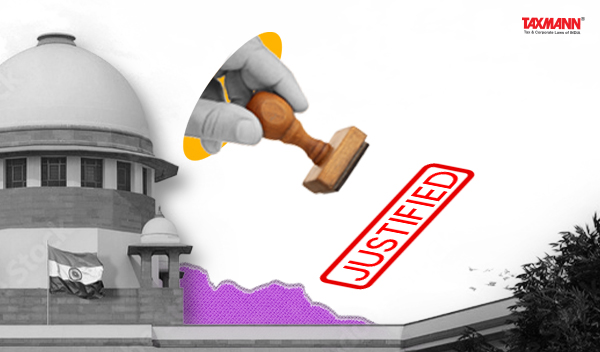HC Justified Invoking GAAR as Issuance of Bonus Shares Was an Artificial Arrangement to Avoid Tax Obligations
- Blog|News|Income Tax|
- 3 Min Read
- By Taxmann
- |
- Last Updated on 13 June, 2024

Case Details: Ayodhya Rami Reddy Alla v. PCIT - [2024] 163 taxmann.com 277 (Telangana)
Judiciary and Counsel Details
- P. Sam Koshy & Laxmi Narayana Alishetty, JJ.
Facts of the Case
In the given case, the assessee sold the shares of a company to a private limited company. Before the sale, the company issued bonus shares to its shareholders. Due to the issuance of bonus shares, the face value of each share of the company was reduced. The sale of shares resulted in a short-term capital loss to the assessee.
The assessee set off the short-term capital loss against the long-term gains made on another transaction of the sale of shares. The Assessing Officer (AO) treated said transaction as an impermissible avoidance arrangement as per the General Anti-Avoidance Rules (GAAR) under Chapter X-A starting from Section 95-102 of the Income Tax Act.
Assessee filed writ petition before the Telangana High Court.
Assessee contended that the transactions resulting in bonus stripping were subject to the specific provisions of Section 94(8), which is a Specific Anti Avoidance Rule (SAAR). Any loss incurred on account of the purchase and sale of shares, resulting in bonus stripping, must be computed as per Section 94(8). However, the AO sought to treat the transactions as impermissible avoidance arrangements as per the GAAR.
Assessee also relied upon 2012 Shome Committee Report. It was submitted that the Committee have recommended that where SAAR is applicable to a particular transaction, then GAAR should not be invoked to look into that element.
High Court Held
The High Court held that the assessee’s argument was rooted in the belief that the Specific Anti Avoidance Rules (SAAR), particularly Section 94(8), should take precedence over the General Anti Avoidance Rule (GAAR). This contention, however, was fundamentally flawed and lacked consistency.
Given the multiple transactions that the taxpayer had undertaken, the case should fall under the umbrella of Chapter X-A and not Chapter X. Section 94(8) might be relevant in a simple, isolated case of the issuance of bonus shares, provided such issuance has an underlying commercial substance. However, this provision did not apply to the current case, as the issuance of bonus shares here was evidently an artificial avoidance arrangement that lacked any logical or practical justification.
It was clear that the assessee’s arrangement was primarily designed to sidestep tax obligations in direct contravention of the principles of the Act. The landmark Vodafone judgment provides crucial insight into this issue. The judgment implies that the business intent behind a transaction could be strong evidence that the transaction isn’t a deceptive or artificial arrangement. The commercial motive behind a transaction often reveals the true nature of the transaction.
The GAAR chapter, which comprises sections 95 to 102, provides a detailed account of various types of transactions that could be considered illegal tax avoidance arrangements. This Chapter lists these transactions and provides an extensive definition of conditions that render a transaction or arrangement devoid of commercial substance.
Furthermore, Section 100 of this Chapter clarifies that this Chapter is applicable in addition to or as a substitute for any other existing method of determining tax liability. This provision emphasizes the legislative intention that the GAAR provisions should act as an all-encompassing safety net. It’s designed to capture all illicit arrangements, ensuring that tax on these arrangements is calculated using the provisions of this Chapter.
Further, the Committee’s stance that SAAR should generally supersede GAAR mainly pertains to international agreements, not domestic cases. This stand, as per the report, is further substantiated by the Finance Minister’s declaration, made on January 14, 2013. During this announcement, the Minister stated that the applicability of either GAAR or SAAR would be determined on a case-by-case basis.
Therefore, the assessee’s contention that the case should have otherwise fallen under Section 94(8) was not acceptable. It was clear and convincing that the entire arrangement was intricately designed to evade tax. Assessee, on his part, hadn’t been able to provide substantial and persuasive proof to counter this claim. Accordingly, the writ petition was dismissed, and AO was allowed to proceed.
List of Cases Referred to
- India v. Shiv Dayal Soin & Sons (P) ltd. And Others 4 SCC 695 (para 17)
- Commercial Tax Officer, Rajasthan v. Binami Cements Limited and Another 8 SCC 319 (para 17).
Disclaimer: The content/information published on the website is only for general information of the user and shall not be construed as legal advice. While the Taxmann has exercised reasonable efforts to ensure the veracity of information/content published, Taxmann shall be under no liability in any manner whatsoever for incorrect information, if any.




